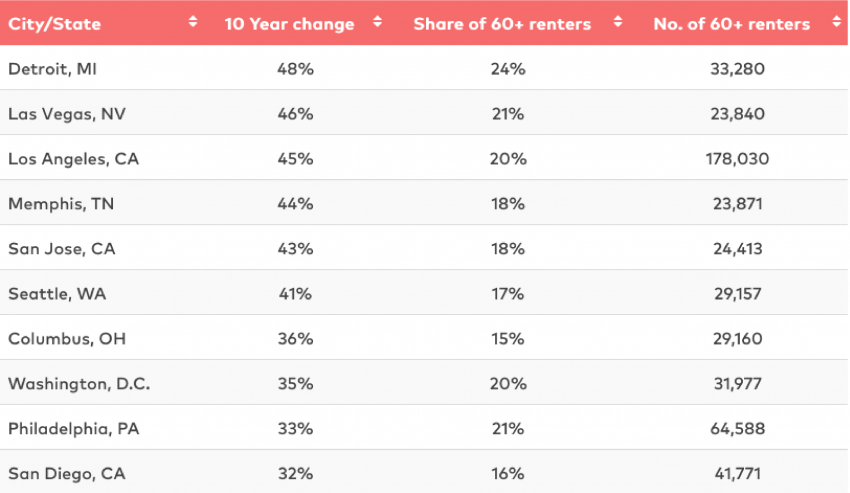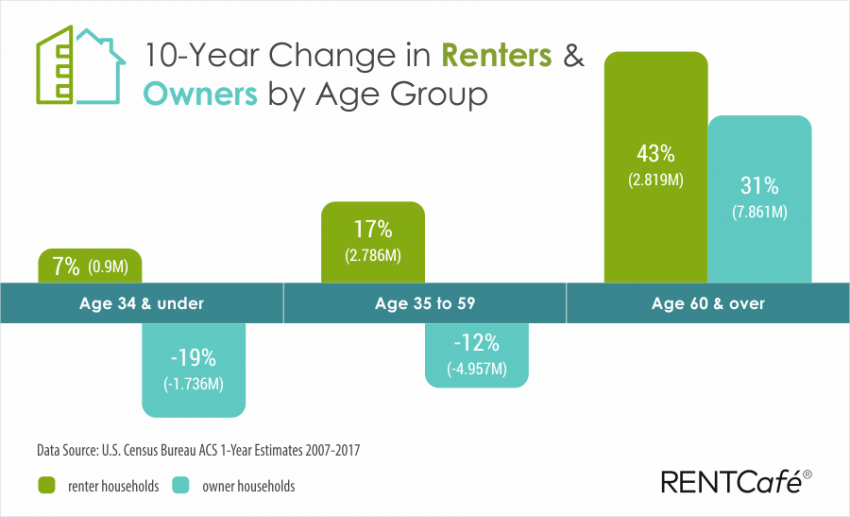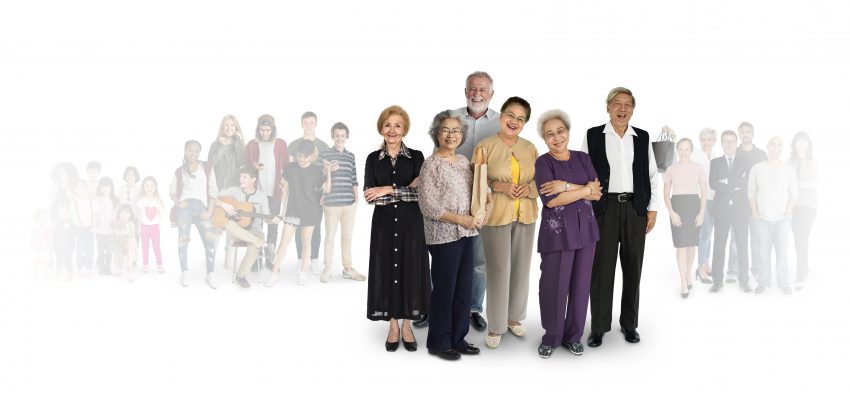The Next Gen of Renters: Mom and Dad – Renters over 60 Grew by 43% in a Decade
by Florentina Sarac
Today’s demographics look substantially different than they did only a decade ago due to America’s older population growing significantly and at a very fast pace. According to Census data, the U.S. is a rapidly aging country, with more than 22% of the current population being aged 60 & over.
The overall aging of the population is not just the result of the economic hardship following the 2007 Great Recession, reflected in declining birth rates, but also the result of the Baby Boom cohort, America’s largest living adult generation, passing age 53 in 2017.
Our research shows that as the 60+ cohort grew bigger and faster, it also helped push the national median age from 36.7 in 2007 to 38.1 in 2017, the highest it’s ever been.

Taking into consideration the decline in births, as well as the higher life expectancy, this trend will likely continue uninterrupted. But which parts of the country have contributed more to this rapid graying of America?
The oldest cities by median age in the U.S. are popular retirement spots
Our top 30 oldest cities all have a median age over 39.6 and are mostly retirement cities in Florida, California, or Arizona. In fact, Florida is home to 12 of the oldest cities, with Cape Coral, first in our top, boasting a median age of 47.9, followed by Hialeah, with 46.5. Sunny Scottsdale, AZ is third in our top, with a median age of 46, proving once more its high popularity among retirees in search of warm days and entertainment.
The population’s median age increase is also reflected in the median household age that saw a steady increase over the 10-year period, reaching 52 in 2017.
Renter households over 60 are up by 43%, outpacing owner households and growing faster than other age groups

As expected, renter householders tend to be younger, with a median age of 42 in 2017, compared to owner householders that had a median age of 56 in the same year. Moreover, the rapid aging of householders is visible throughout the 10-year period analyzed with both renter and owner householders getting older. But the median age of renters has been slowly closing the gap over the last decade.
Renter households aged 60 and over drove the past decade’s surge in renters, with a 43% increase, from 6.551M to 9.37M in 2017, greatly outpacing younger age groups. While those aged 35 to 59 grew by 17% from 16.325M to 19.111M, renters aged under 35 witnessed the slowest increase rate of 7%, growing from 13.987M to 14.898M in a decade. Likewise in net numbers, the U.S. gained more new senior renter households in the past ten years than in either of the two younger renter age groups.

Stemming from a decline in homeownership, older renter households increased faster than older owner households – 43% versus 31%. The rapid growth of the 60+ population is also visible across owner households as the only increase in the 10-year period between 2007 and 2017 was witnessed by seniors over 60. Those aged 34 and under saw a 19% decrease and owner households between 35 and 59 decreased by 12%.
Past studies we conducted show that the older population is no longer enthusiastic about homeownership, with many seniors starting to downsize and move into rentals. As their children move out, they find themselves alone, in a big house that costs a lot to maintain, causing them to rethink their housing choices.
Austin boasts the highest 10-year percentage change in the share of older renter households
Out of the 30 most populous cities in the U.S., 16 experienced an increase of over 40% in the 60+ renter household share between 2007 and 2017. Austin, TX takes the first place as the city with the highest percentage change in the share of 60+ renter households, increasing by 113% in the 10-year period. Phoenix, AZ is also present in this top with the second highest increase of 112% and it’s followed by another Texas city: Fort Worth, with 95%.
On the other hand, New York had the largest share of 60+ renter households in 2017 – of 27% or 572,130 renter households. It’s also important to point out that New York is the only one in our top to have more 60+ renter households than under 34. However, this might not come as an absolute surprise if we think about the city’s infamously high rents, generally unaffordable to those under 34.
The second highest share of 60+ renter households is claimed by Baltimore, MD – of 25%, followed by Detroit, MI and San Francisco, CA with 24%. All top 11 cities have over 20% shares of older renter households, including Las Vegas, NV, Philadelphia, PA, Boston, MA, Chicago, IL, Los Angeles, CA, Lousiville, KY, and Washington, D.C.
By 2035, the 60+ renter share is projected to keep growing while that of all other age groups will decrease
According to our projection based on the trend witnessed between 2007 and 2017, we expect the year 2035 will mark a major demographic shift with the share of 60+ renter households reaching somewhere around 31% and becoming the second highest share among all age groups. Despite being the majority, those aged between 35 and 59 will likely see a decrease in their share of renter households, dropping from 44% in 2017 to an estimated 43% in 2035. However, the most notable decline is projected to take place among those aged 34 and under, with their to decrease from 34% to 27% by 2035.
In terms of net numbers, the 60+ cohort is expected to grow to an estimated 18.6M by 2035 and will become the second largest group of renter households, surpassing those aged 34 and under.
This growing share of older Americans is bound to have an impact on the U.S. real estate market. This is a cohort of people that witnessed firsthand the impact of the 2007 housing crisis and the re-shaping of the economy, forcing most of them to give up their homeowner status and move into rental apartments. It’s important for developers to acknowledge the particular housing needs of older renters and make sure that they are being met.
Florentina Sarac is a creative writer for RENTCafé, where she covers everything from real estate news to market reports. She holds a BA in English and Spanish, as well as an MA in Multilingual and Multicultural Communication.




